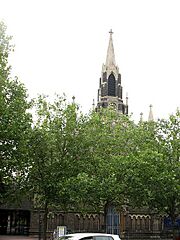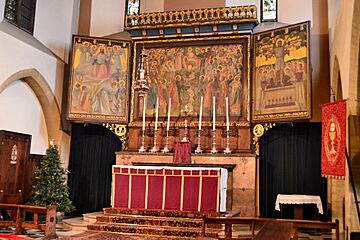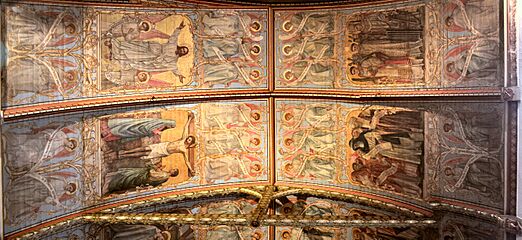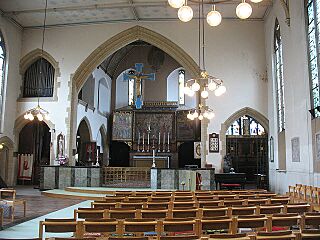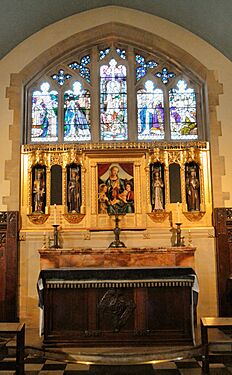St John the Divine, Richmond facts for kids
Quick facts for kids St John the Divine, Richmond |
|
|---|---|
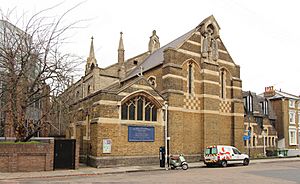
St John the Divine from St John's Road, Richmond
|
|
| 51°27′51″N 0°18′01″W / 51.4642°N 0.3003°W | |
| Location | Richmond, London |
| Country | England |
| Denomination | Church of England |
| History | |
| Founded | 1831 |
| Architecture | |
| Architect(s) | Lewis Vulliamy (original building); Arthur Grove (later additions and church hall) |
| Style | Early Gothic Revival |
| Completed | 1836 |
| Administration | |
| Parish | St John the Divine, Richmond |
| Deanery | Richmond & Barnes |
| Archdeaconry | Wandsworth |
| Episcopal area | Kingston |
| Diocese | Southwark |
| Province | Canterbury |
St John the Divine, Richmond is a beautiful and historic church in Richmond, London. It is part of the Church of England and is located on Kew Road, very close to Richmond railway station. The church was built in 1836 and is recognized as a Grade II listed building. This means it is an important historical site that needs to be protected.
The church was designed by an architect named Lewis Vulliamy. He used a style called Early Gothic Revival, which looks a bit like older medieval churches. Since 1996, St John the Divine has worked together with two other churches, St Mary Magdalene and St Matthias, as part of the Richmond Team Ministry.
Contents
The Church's History
Richmond grew a lot in the 1700s and early 1800s. By the 1820s, the main church, St Mary Magdalene, was too small for everyone. People realized they needed another church.
Building St John the Divine
Work on St John the Divine started in 1831 and finished in 1836. A local landowner, William Selwyn, provided the land for the church. Lewis Vulliamy was the architect who designed it. Some experts have noted its unique spire and flying buttresses. In 1838, St John the Divine became a parish church on its own.
The Church Organ
The church has a special organ that was built by Beale and Thynne. It was first used in December 1896. This organ is very old but has been carefully fixed up. It is still almost exactly as it was when it was first built.
Additions in the 1900s
More parts were added to the church between 1904 and 1905. These included a chancel (the area around the altar), a south chapel, and vestries (rooms for clergy). These new parts were designed by Arthur Grove.
In 1908, an artist named Nathaniel Westlake painted the ceiling of the sanctuary (the holiest part of the church). He also created a special three-part artwork called a triptych that stands behind the altar. Westlake also painted pictures showing the Stations of the Cross, but these are no longer there. They were replaced later by stone carvings made by Freda Skinner.
Eric Gill carved some of the stonework on the triptych and above a door. Outside the church, on the east side, there is a sculpture called the Calvary. It was carved by Richard Garbe.
A separate church hall, made of brick, was built in 1911. Later, in 1980 and 1981, the church was changed so it could also be used for concerts and meetings. New rooms and facilities were added.
Restoration in the 2000s
In the early 2000s, a special screen behind the altar in the Lady Chapel was restored. This work was done by Howell and Bellion.
Important People
Vigo Auguste Demant (1893–1983) was the vicar at St John the Divine from 1933 to 1942. He later became a Canon at St Paul's Cathedral and a professor at Oxford University. He was also a regular speaker on the BBC in the 1950s.
Worship Services
The church describes its worship style as "modern/liberal Catholic." This means it combines traditional elements with a more open approach. Services are held regularly. The main service, called Eucharist, takes place at 11:00 am on Sundays and at 7:00 pm on Tuesdays.
Photo gallery



